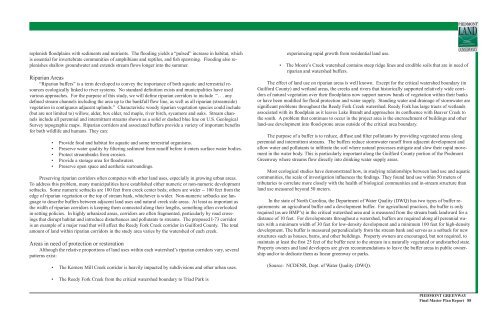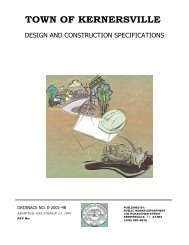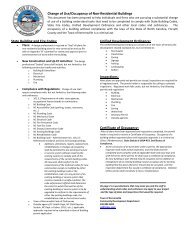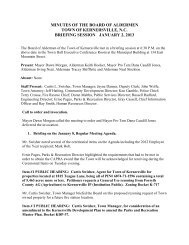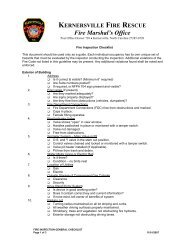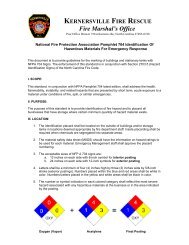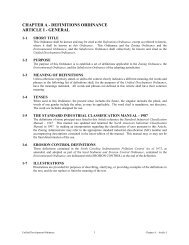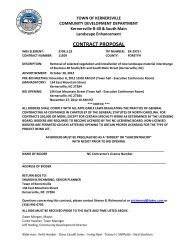Piedmont Greenway Master Plan - Town of Kernersville
Piedmont Greenway Master Plan - Town of Kernersville
Piedmont Greenway Master Plan - Town of Kernersville
- No tags were found...
You also want an ePaper? Increase the reach of your titles
YUMPU automatically turns print PDFs into web optimized ePapers that Google loves.
eplenish floodplains with sediments and nutrients. The flooding yields a “pulsed” increase in habitat, which<br />
is essential for invertebrate communities <strong>of</strong> amphibians and reptiles, and fish spawning. Flooding also replenishes<br />
shallow groundwater and extends stream flows longer into the summer.<br />
Riparian Areas<br />
“Riparian buffers” is a term developed to convey the importance <strong>of</strong> both aquatic and terrestrial resources<br />
ecologically linked to river systems. No standard definition exists and municipalities have used<br />
various approaches. For the purpose <strong>of</strong> this study, we will define riparian corridors to include “. . . any<br />
defined stream channels including the area up to the bankfull flow line, as well as all riparian (streamside)<br />
vegetation in contiguous adjacent uplands.” Characteristic woody riparian vegetation species could include<br />
(but are not limited to) willow, alder, box elder, red maple, river birch, sycamore and oaks. Stream channels<br />
include all perennial and intermittent streams shown as a solid or dashed blue line on U.S. Geological<br />
Survey topographic maps. Riparian corridors and associated buffers provide a variety <strong>of</strong> important benefits<br />
for both wildlife and humans. They can:<br />
• Provide food and habitat for aquatic and some terrestrial organisms.<br />
• Preserve water quality by filtering sediment from run<strong>of</strong>f before it enters surface water bodies.<br />
• Protect streambanks from erosion.<br />
• Provide a storage area for floodwaters.<br />
• Preserve open space and aesthetic surroundings.<br />
Preserving riparian corridors <strong>of</strong>ten competes with other land uses, especially in growing urban areas.<br />
To address this problem, many municipalities have established either numeric or non-numeric development<br />
setbacks. Some numeric setbacks are 100 feet from creek center beds; others are wider -- 100 feet from the<br />
edge <strong>of</strong> riparian vegetation or the top <strong>of</strong> stream bank, whichever is wider. Non-numeric setbacks use language<br />
to describe buffers between adjacent land uses and natural creek side areas. At least as important as<br />
the width <strong>of</strong> riparian corridors is keeping them connected along their lengths, something <strong>of</strong>ten overlooked<br />
in setting policies. In highly urbanized areas, corridors are <strong>of</strong>ten fragmented, particularly by road crossings<br />
that disrupt habitat and introduce disturbances and pollutants to streams. The proposed I-73 corridor<br />
is an example <strong>of</strong> a major road that will affect the Reedy Fork Creek corridor in Guilford County. The total<br />
amount <strong>of</strong> land within riparian corridors in the study area varies by the watershed <strong>of</strong> each creek.<br />
Areas in need <strong>of</strong> protection or restoration<br />
Although the relative proportions <strong>of</strong> land uses within each watershed’s riparian corridors vary, several<br />
patterns exist:<br />
• The Kerners Mill Creek corridor is heavily impacted by subdivisions and other urban uses.<br />
experiencing rapid growth from residential land use.<br />
• The Moore’s Creek watershed contains steep ridge lines and erodible soils that are in need <strong>of</strong><br />
riparian and watershed buffers.<br />
The effect <strong>of</strong> land use on riparian areas is well known. Except for the critical watershed boundary (in<br />
Guilford County) and wetland areas, the creeks and rivers that historically supported relatively wide corridors<br />
<strong>of</strong> natural vegetation over their floodplains now support narrow bands <strong>of</strong> vegetation within their banks<br />
or have been modified for flood protection and water supply. Standing water and drainage <strong>of</strong> stormwater are<br />
significant problems throughout the Reedy Fork Creek watershed. Reedy Fork has large tracts <strong>of</strong> wetlands<br />
associated with its floodplain as it leaves Lake Brandt and approaches its confluence with Beaver Creek to<br />
the south. A problem that continues to occur in the project area is the encroachment <strong>of</strong> buildings and other<br />
land-use development into flood-prone areas outside <strong>of</strong> the critical area boundary.<br />
The purpose <strong>of</strong> a buffer is to reduce, diffuse and filter pollutants by providing vegetated areas along<br />
perennial and intermittent streams. The buffers reduce stormwater run<strong>of</strong>f from adjacent development and<br />
allow water and pollutants to infiltrate the soil where natural processes mitigate and slow their rapid movement<br />
in the water body. This is particularly important along the Guilford County portion <strong>of</strong> the <strong>Piedmont</strong><br />
<strong>Greenway</strong> where streams flow directly into drinking water supply areas.<br />
Most ecological studies have demonstrated how, in studying relationships between land use and aquatic<br />
communities, the scale <strong>of</strong> investigation influences the findings. They found land use within 50 meters <strong>of</strong><br />
tributaries to correlate more closely with the health <strong>of</strong> biological communities and in-stream structure than<br />
land use measured beyond 50 meters.<br />
In the state <strong>of</strong> North Carolina, the Department <strong>of</strong> Water Quality (DWQ) has two types <strong>of</strong> buffer requirements:<br />
an agricultural buffer and a development buffer. For agricultural practices, the buffer is only<br />
required (as are BMP’s) in the critical watershed area and is measured from the stream bank landward for a<br />
distance <strong>of</strong> 10 feet. For developments throughout a watershed, buffers are required along all perennial waters<br />
with a minimum width <strong>of</strong> 30 feet for low-density development and a minimum 100 feet for high-density<br />
development. The buffer is measured perpendicularly from the stream bank and serves as a setback for new<br />
structures such as houses, barns, and other buildings. Property owners are encouraged, but not required, to<br />
maintain at least the first 25 feet <strong>of</strong> the buffer next to the stream in a naturally vegetated or undisturbed state.<br />
Property owners and land developers are given recommendations to leave the buffer areas in public ownership<br />
and/or to dedicate them as linear greenway or parks.<br />
(Source: NCDENR, Dept. <strong>of</strong> Water Quality (DWQ).<br />
• The Reedy Fork Creek from the critical watershed boundary to Triad Park is<br />
PIEDMONT GREENWAY<br />
Final <strong>Master</strong> <strong>Plan</strong> Report 88


